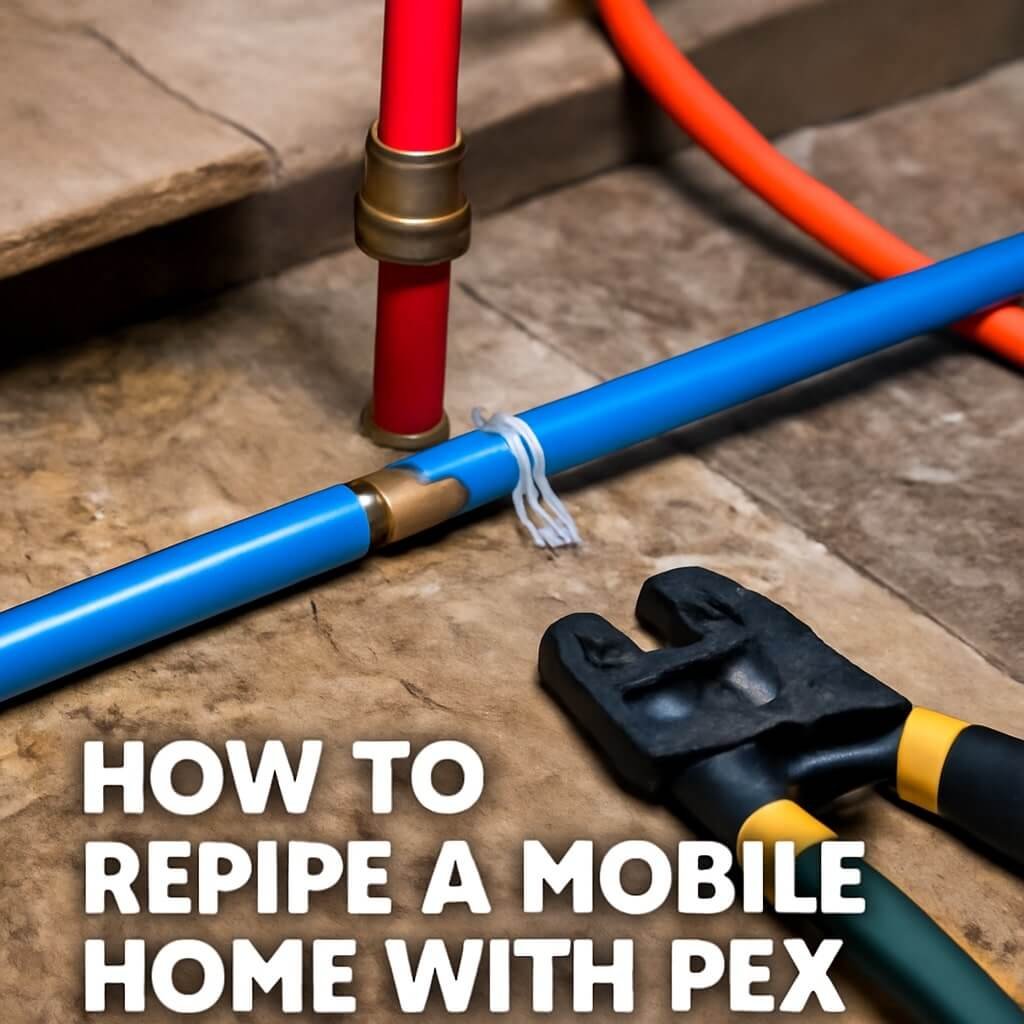Repiping a mobile home is a critical maintenance task that ensures the plumbing system runs smoothly and safely. If you’re wondering how to repipe a mobile home with PEX, you’re about to discover a practical, durable, and cost-effective method. PEX piping has gained popularity for mobile homes due to its flexibility, resistance to corrosion, and ease of installation.
This guide covers everything from recognising when it’s time to repipe to the step-by-step installation process and maintenance tips. Whether you’re a seasoned DIYer or planning to hire a pro, understanding how to work with PEX will empower you to improve your mobile home’s plumbing system.
What is PEX Piping and Why Use It in Mobile Homes?
PEX stands for cross-linked polyethylene, a type of plastic tubing designed for plumbing systems. Unlike rigid copper or galvanised steel pipes, PEX is highly flexible and can be bent around corners without the need for many fittings. This flexibility is particularly useful in mobile homes, where space is limited and plumbing layouts can be tricky.
Benefits of PEX for mobile homes include:
- Corrosion resistance: PEX doesn’t rust or corrode, unlike metal pipes, extending its lifespan.
- Freeze resistance: It can expand slightly under freezing conditions, reducing burst risks.
- Easy installation: PEX uses fewer fittings and can be installed faster, saving time and labor.
- Cost-effectiveness: Generally cheaper than copper piping and easier to maintain.
Signs You Need to Repipe Your Mobile Home
Knowing when to repipe can save you from costly water damage and plumbing failures. Common signs include:
- Persistent leaks or dripping faucets
- Low water pressure throughout the home
- Discoloured or foul-smelling water
- Frequent pipe bursts or repairs
- Corrosion is visible on existing pipes
- Old galvanised steel piping, which is prone to rust and clogging
If these symptoms sound familiar, it’s time to consider repiping your mobile home with PEX.
Tools and Materials Needed for PEX Repipe
Before you start, gather all necessary tools and materials to ensure a smooth process:
| Item | Purpose |
|---|---|
| PEX tubing (appropriate diameter) | Main piping material |
| PEX fittings (tees, elbows, couplings) | Connect and change pipe direction |
| PEX crimp rings or cinch clamps | Secure fittings to pipes |
| PEX crimp tool or cinch tool | Tighten clamps or crimp rings |
| Pipe cutter or tubing cutter | Cut PEX pipe cleanly |
| Measuring tape | Measure pipe lengths |
| Marker | Mark cutting points |
| Pipe supports/clamps | Secure pipes in place |
| Teflon tape | Seal threaded connections |
| Adjustable wrench | Tighten fittings and fixture connections |
| Safety gloves and goggles | Protect yourself during installation |
Having the right tools upfront can save time and reduce frustration.
Step 1: Preparing Your Mobile Home for Repipe Work
Preparation is key before you repipe:
- Turn off the main water supply.
- Drain the plumbing system by opening all faucets and valves.
- Shut off electricity to any areas where you will work, especially near water.
- Clear access areas to pipes — remove panelling or flooring as needed.
- Have a plan for the waste disposal of old pipes.
Good preparation minimises risks and speeds up the project.
Step 2: Removing Old Pipes
Removing old galvanised or copper pipes requires care:
- Cut pipes close to joints with a pipe cutter or hacksaw.
- Avoid damaging walls or flooring.
- Remove fittings that can be reused if applicable.
- Dispose of old pipes following local regulations.
Removing the old plumbing prepares the path for new PEX pipes.
Step 3: Planning Your New PEX Pipe Layout
Before installation, plan your piping layout:
- Measure distances between fixtures.
- Sketch a piping diagram, marking pipe runs and fitting points.
- Consider future expansions or repairs.
- Identify shut-off valves for individual fixtures.
A well-planned layout reduces waste and improves efficiency.
Step 4: Installing PEX Pipes
Installation tips include:
- Cut PEX pipes to the required lengths using a pipe cutter.
- Use crimp rings or cinch clamps to attach fittings.
- Avoid sharp bends beyond PEX’s flexibility.
- Secure pipes with clamps to prevent movement and noise.
PEX installation is faster and cleaner than traditional methods.
Step 5: Connecting PEX Pipes to Fixtures
Use appropriate fittings for connections:
- Threaded adapters for faucets and appliances.
- Compression fittings where necessary.
- Apply Teflon tape on threaded connections.
- Ensure connections are tight but avoid overtightening.
Proper connections prevent leaks and water damage.
Step 6: Testing the New PEX Plumbing System
Testing is crucial before sealing walls or flooring:
- Turn on the water supply gradually.
- Check all joints and fittings for leaks.
- Monitor water pressure with a gauge.
- Inspect the system for at least 30 minutes.
Fix any leaks immediately to avoid future problems.
Step 7: Troubleshooting Common Issues
Common issues and solutions:
| Problem | Cause | Solution |
|---|---|---|
| Leak at fitting | Loose crimp or clamp | Straighten the pipe or flush system |
| Low water pressure | Kinked pipe or blockage | Straighten pipe or flush system |
| No hot water flow | Incorrect pipe layout | Check connections and correct installation |
| Noise in pipes | Loose pipe supports | Secure pipes firmly |
Knowing how to troubleshoot helps maintain system integrity.
Maintenance Tips for PEX Plumbing in Mobile Homes
To prolong your PEX system:
- Regularly inspect visible pipes for wear or damage.
- Avoid exposing PEX to direct sunlight.
- Insulate pipes in colder areas.
- Flush water heaters periodically.
- Keep fittings tight and check for leaks annually.
Routine maintenance extends plumbing lifespan.
Cost and Time Considerations for Mobile Home Repipe Projects
Typical cost factors include:
- Material costs (PEX tubing and fittings)
- Labour (DIY vs. professional installation)
- Removal of old pipes
- Permits and inspections
On average, repiping a mobile home can take 2–5 days and costs vary widely based on location and project complexity.
FAQs About Repiping with PEX in Mobile Homes
Can I install PEX pipes myself in a mobile home?
Yes, with the right tools and preparation, DIY installation is possible, but professional help ensures compliance with local codes.
How long does PEX piping last?
PEX pipes typically last 25-40 years, depending on water quality and maintenance.
Is PEX safe for drinking water?
Yes, PEX is approved for potable water and does not leach harmful chemicals.
Can PEX be used for hot water lines?
PEX is rated for both hot and cold water supply lines.
What if my mobile home has aluminium wiring near plumbing?
Ensure electrical wiring is properly insulated and consult a professional to avoid hazards.
Are there any special permits required for repiping?
Local codes vary; check with your municipality to ensure compliance.
Conclusion: Benefits of Repiping with PEX for Mobile Homes
Repiping your mobile home with PEX brings enhanced durability, flexibility, and cost savings. The ease of installation and resistance to common plumbing issues make PEX an excellent choice. With proper planning, execution, and maintenance, you’ll enjoy a reliable plumbing system for years to come.













